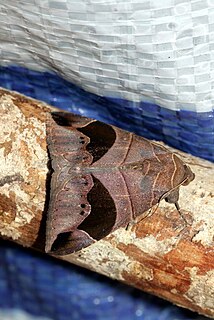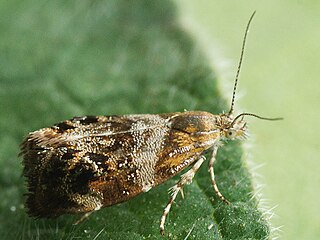Related Research Articles

The Hepialidae are a family of insects in the lepidopteran order. Moths of this family are often referred to as swift moths or ghost moths.

Roland Trimen FRS was a British-South African naturalist, best known for South African Butterflies (1887–89), a collaborative work with Colonel James Henry Bowker. He was among the first entomologists to investigate mimicry and polymorphism in butterflies and their restriction to females. He also collaborated with Charles Darwin to study the pollination of Disa orchids.

Arthur Gardiner Butler F.L.S., F.Z.S. (1844–1925) was an English entomologist, arachnologist and ornithologist. He worked at the British Museum on the taxonomy of birds, insects, and spiders.

Nepticulidae is a family of very small moths with a worldwide distribution. They are characterised by eyecaps over the eyes. These pigmy moths or midget moths, as they are commonly known, include the smallest of all living moths, with a wingspan that can be as little as 3 mm in the case of the European pigmy sorrel moth, but more usually 3.5–10 mm. The wings of adult moths are narrow and lanceolate, sometimes with metallic markings, and with the venation very simplified compared to most other moths.

Pterolonchidae is a small family of very small moths in the superfamily Gelechioidea. There are species native to every continent except Australia and Antarctica.

Bastilla joviana is a moth of the family Noctuidae first described by Stoll in 1782. It is found from the Oriental region to the Moluccas and in New Guinea and Australia. It is also present in South Africa.

Many populations of Lepidoptera migrate, sometimes long distances, to and from areas which are only suitable for part of the year. Lepidopterans migrate on all continents except Antarctica, including from or within subtropical and tropical areas. By migrating, these species can avoid unfavorable circumstances, including weather, food shortage, or over-population. In some lepidopteran species, all individuals migrate; in others, only some migrate.
Micragrotis interstriata is a species of moth of the family Noctuidae first described by George Hampson in 1902. It is found in Africa, including Zimbabwe and South Africa.
Heliothis galatheae is a species of moth of the family Noctuidae first described by Hans Daniel Johan Wallengren in 1856. It is found all over Africa, including South Africa to Ethiopia and the Gambia.
Heliothis leucosticta is a species of moth of the family Noctuidae first described by George Hampson in 1902. It is found in Africa, including Botswana and South Africa.
Heliothis sublimis is a species of moth of the family Noctuidae first described by Emilio Berio in 1962. It is found in Africa, including South Africa.
Heliocheilus multiradiata is a species of moth of the family Noctuidae first described by George Hampson in 1902. It is found in Africa, including South Africa and Zimbabwe.
Heliocheilus biocularis is a species of moth of the family Noctuidae first described by Max Gaede in 1915. It is found in Africa, including South Africa.
Adisura bella is a species of moth of the family Noctuidae first described by Max Gaede in 1915. It is found in Africa, including South Africa, Somalia, Tanzania and Saudi Arabia
Varius ochnicola is the only species in the monotypic moth genus Varius of the family Nepticulidae. The genus was erected by Scoble in 1983. The species was first described by Vari in 1955. It is found in South Africa.
The Micronoctuini are a tribe of moths in the family Erebidae that includes about 400 described species. Typical species in the tribe have bifine hindwing venation and are smaller than those in other noctuoid moths. Micronoctua karsholti is the smallest of all species in the superfamily Noctuoidea.
Agrionympha capensis is a species of moth belonging to the family Micropterigidae. It was described by Whalley in 1978. It is known from South Africa, where it is found in the Western and Eastern Cape districts.
Agrionympha pseliacma is a species of moth belonging to the family Micropterigidae. It was described by Edward Meyrick in 1921. It is found in South Africa, where it is known only from Karkloof Falls in Kwazulu-Natal.
Louis Beethoven Prout (1864–1943) was an English entomologist and musicologist.

Tebenna bjerkandrella is a moth of the family Choreutidae first described by Carl Peter Thunberg in 1784. It is found from Europe, Morocco, Madeira and the Canary Islands through central Asia to Japan. It has also been recorded from South Africa.
References
- ↑ Gaede, M. (1915). "Neue afrikanische Lepidoptera des Berliner Zoologischen Museums". Internationale Entomologische Zeitschrift. Guben. 9:38–40, pl. 1.(in German)